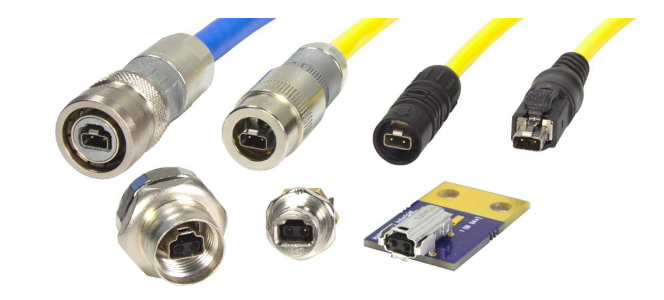The industrial manufacturing sector has seen significant changes these past twenty years. Increasingly, production assets are connected to control and performance analysis systems. The industrial networking environment is often diverse, with Ethernet as the backbone network to IT enterprise systems. An eclectic mix of low-speed serial bus methods forms the connections to the operational technology (OT) used on the industrial equipment. Managing multiple network protocols is a challenge and no longer suitable for modern IIoT systems, such as vision imaging, for real-time high bandwidth applications. This article outlines the recent single pair Ethernet development and how the Ethernet protocol can link from enterprise IT systems right down to the OT edge.
The rise of the connected machines
Industrial transformation initiatives such as Industry 4.0 are responsible for invigorating many factories and manufacturing operations. With a focus on improving a process or facility’s overall operational effectiveness, gathering data is paramount. Timing is often crucial to the success of many things in life, and that was certainly the case when Industry 4.0 met the concept of the Internet of Things (IoT). The IoT, specifically now the Industrial IoT (IIoT), was exactly what was needed to link up motors, sensors, actuators, and the myriad of other control equipment used in an automated process.
However, connecting control systems and components is not a new concept. For over forty years, industrial process controllers have used serial networking protocols such as Profibus, RS232/422, and Modbus. Interfacing between enterprise IT systems became a complex task for dedicated gateways and servers.
The Ethernet legacy
The world of computing has changed a lot since the ‘80s. Initially, connecting individual computers together was complicated, with many proprietary network protocols competing to dominate. Ethernet was one such protocol that emerged to become the ubiquitous and widely adopted IEEE 802.3 networking standard.
Figure 1 illustrates how Ethernet has evolved in terms of bandwidth since its ratification as 802.3.

As Ethernet evolved and its flexibility, resilience, and convenience became respected, it developed as a natural candidate for applications outside its traditional markets. Ethernet quickly became a viable standard for automotive in-vehicle networking and building automation applications. Industrial Ethernet adaptations such as real-time, deterministic time-sensitive networking (TSN), and its ability to transport multiple legacy protocols, demonstrates Ethernet’s suitability for all types of automation.
Industrial networking requirements
The industrial environment is unlike most offices and data centres. The Ethernet’s defacto RJ45 four-pair twisted-pair connector arrangement used in our homes and offices is poorly suited to industrial use. Network cables and connectors linking production assets and sensors to control systems experience a harsh operating environment with specific mechanical constraints. Environmental factors include vibration, humidity, and the need for ingress protection. In space-constrained industrial control cabinets, equipment density is high, and cables need to be very flexible and capable of a tight bending radius. Likewise, protecting cables within metal conduits places constraints on the cable sizes used.
The rapid growth in the deployment of smart edge based IIoT devices necessitates a power source in addition to wired connectivity. Ethernet offers a power over Ethernet (PoE) capability, but the thickness, weight, and cost of installing a traditional eight conductor Ethernet cable preclude its use.
Single pair Ethernet; the perfect choice for industrial applications
The gigabit single pair Ethernet (SPE) standard, IEEE 802.3bp 1000BASE-T1, was established in 2019. As the name suggests, it uses a single twisted pair of conductors and offers a maximum link distance of 15 metres using unshielded cables and 40 metres with shield cables. Compared to a regular four-pair Ethernet Cat 6 cable using AWG 23 conductors, an SPE cable is 60 % lighter and has significantly less diameter. As highlighted, the RJ45 connector is unsuitable for industrial use, necessitating further investigation into a connector format that the industry could adopt. March 2020 saw the launch of the announcement of the IEC 63171 connector standard for SPE.
A power delivery capability standard termed power over data line (PoDL) is defined in IEEE 802.3bu. Nine current and voltage combinations classes allow for a maximum of 50 Watts delivered to the end device. A recent revision to the PoDL standard, 802.3cg, adds six classes, see Figure 2, which stipulates a maximum of 52 Watts delivered to the load. The standard also highlights the need for a slight increase in conductor diameter and defines the maximum conductor resistance to achieve the highest power delivery capabilities.

The IEC 63171-1 to 63171-6 standards define a set of different SPE connector formats – see Figure 3. They accommodate separate and over data line power delivery capabilities, ingress protection, and using shielded or unshielded cable types. The widespread industrial circular connector types M8 and M12 form part of the robust IP65/67 line-up.

Single pair Ethernet; delivering robust network connectivity from the data centre to the industrial endpoints
The widely respected Ethernet protocol delivers resilient, reliable, and enterprise-grade networking. Now, with the advent of IEEE 802.3bp single pair Ethernet and the IEC 63171 SPE connector standard, those same levels of quality of service and power delivery are available to the endpoint. Using a single networking protocol greatly simplifies network infrastructure complexities and costs.











